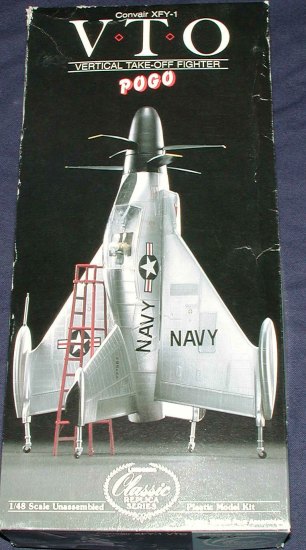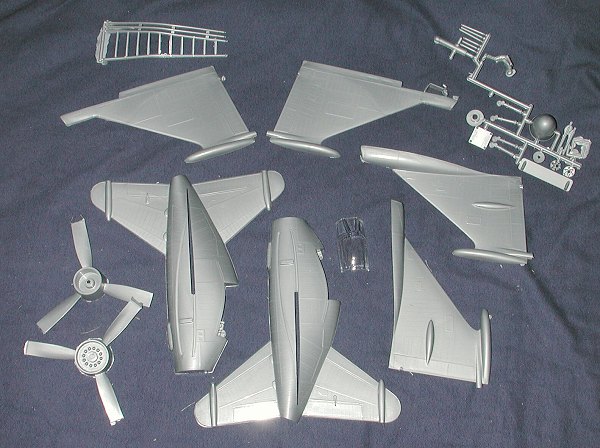
|
KIT: |
Lindberg 1/48 XFY-1 'Pogo' |
|
KIT # |
536 |
|
PRICE: |
? |
|
DECALS: |
One aircraft |
|
REVIEWER: |
|
|
NOTES: |
1987 boxing, originally molded in the late 1950s |

|
HISTORY |
The XFY-1 sat on its tail for landings and takeoffs. It had a large delta wing with two pods at the extreme and two large vertical fins above and below the fuselage. The aircraft rested on a set of small castoring wheels at the tips of the wing and fin. At takeoff, the engines ran up to full power and the aircraft ascended vertically, then when it reached a safe altitude it gradually nosed over into conventional horizontal flight. At landing, the aircraft approached the landing pad while pitched up into a nose-high position and then descended to the ground under gradually reduced power. If an emergency were to occur, the ventral fin could be jettisoned so that the aircraft could make a crash-landing in conventional, wing-supported mode.
The XFY-1 was powered by an Allison YT40-A-6 turboprop (which consisted of two T38 turboprops coupled together) driving a pair of Curtiss-Wright 16-foot three-bladed contra-rotating propellers in the nose. The engine offered a power of 5500 shp. The air intakes for the engines were located in the extended roots of the delta wing, and the exhaust was in the extreme tail.
The single pilot sat underneath a cockpit canopy which slid toward the rear. The ejector seat was mounted on gimbals and tilted 45 degrees when the aircraft was in the vertical position. Entry to or exit from the cockpit required a special ladder, and was by all accounts rather awkward. During takeoffs and landings, the canopy was slid to the rear to give the pilot a better view.
The proposed armament (never actually fitted) was four 20-mm cannon fitted in the two wingtip pods. Alternatively, 48 2 3/4-inch folding-fin rockets could be fitted.
Before attempting the first flights, the prototype XFY-1 was attached to a complex tether system inside a huge hangar at NAS Moffett Field, California that allowed the aircraft to move up or down freely, but severely limited the lateral displacement. During the summer of 1954, test pilot James F. "Skeets" Coleman made several tethered flights in this system. The first un-tethered vertical flight was made on August 1, 1954. During the next two days, several vertical hovering flights were made during which the aircraft reached altitudes as high as 150 feet. The aircraft was then returned to San Diego for further tests at NAAS Brown Field. The first successful transition to horizontal flight took place on November 2, 1954, during which the XFY-1 flew horizontally for 20 minutes before coming back and landing inside a 50-foot square. This was the first successful VTOL flight in history in an aircraft that was not a helicopter or an autogiro. For this feat, Coleman was awarded the Harmon Trophy.
Unfortunately, the XFY-1 was difficult to land because of a poor view from the cockpit of the landing area and the unusual pilot posture. The landing operation would probably have been difficult if not impossible for a pilot of ordinary ability to perform on a small deck aboard ship, especially in rough seas where the deck was pitching back and forth. In addition, the T40 turboprop was mechanically complex and was thoroughly unreliable and subject to frequent breakdowns. The T40 was, in fact, the cause of the failure of several combat aircraft projects of the era. In addition, by this time the performance of the XFY-1 was quite a bit less than that of conventional jet aircraft, and would probably not have been able to hold its own in air-to-air combat. For this reason, the XFY-1 program was cancelled after only 40 hours of flight testing.
Only one of the three XFY-1s actually flew. 138648 was used strictly as an engine testbed and 138650 was used only for static tests. The sole flight article (138649) was displayed for a while at NAS Norfolk, Virginia, but is now in storage at the Paul Garber restoration facility at Suitland, MD.
|
THE KIT |

Lindberg's kit dates from the days when
detail was counted in rivets. To that extent, the XFY-1 is quite detailed. What
is even more surprising is that the rivet detail is remarkably subdued and
rather near scale. Other panel lines are given as raised detail and some panels
themselves stand proud of the surface of the aircraft. There is no cockpit
detail whatsoever with just a generic seat and pilot to fill things out. The
canopy is quite clear and those considering tackling this kit should consider
scratch-building a cockpit as I did when I built this kit
several years ago. ![]()
Other details include the castoring main wheels and an operating contra-rotating prop. A boarding ladder is also included, though the one in this kit is rather warped. There is no intake or exhaust detail and that will have to be added. The instructions are quite basic as you'd expect from a kit with so few parts, but are wholly adequate to complete the kit. Decals are for one plane (bogus serial number). They are thick, glossy and are well printed. They should work fairly well, but you might also consider replacing as many as you can with thinner aftermarket ones.
|
CONCLUSIONS |
For many, this will be a walk down memory lane. For others it will be perceived as a challenge to build a really good model. The outlines appear to be accurate and only requires some detail work. Because it is such a simple model, even beginning modelers should find this one pretty easy to build.
If you would like your product reviewed fairly and quickly by a site that has 200,000 visitors a month, please contact me or see other details in the Note to Contributors.